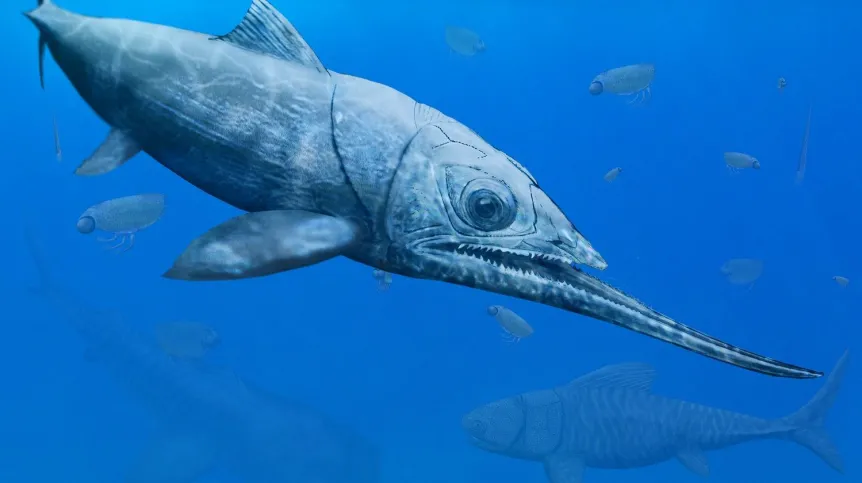
Polish scientists have discovered an over two-meter-long predatory armoured fish with an extremely elongated lower jaw in rock sediments from 365 million years ago in the Świętokrzyskie Mountains. The remains do not resemble any other animals from the Devonian.
A formidable, 2-3-meter-long predator with a jaw twice as long as the skull and sharp teeth preyed on cephalopods or fish in the deep Devonian seas. We owe our knowledge about it to two Polish researchers, as well as a team of scientists from France, Switzerland and Germany conducting parallel research. The results of the joint study have just been published in the journal Royal Society Open Science.
It all started in 1957, when the outstanding Polish paleontologist Julian Kulczycki, the first researcher of vertebrates at the Department of Palaeozoology at the Polish Academy of Sciences, found strange, long bones in the Świętokrzyskie Mountains near Chęciny. He thought they were fish fin spines. He named the species of armoured fish Alienacanthus malkowskii. Kulczycki chose the second part of the Latin name of the animal to honour Professor Stanisław Małkowski, an employee of the Polish Geological Institute and the first director of the Earth Museum of the Polish Academy of Sciences.
More than 50 years later, another palaeontologist, Dr. Piotr Szrek from the Polish Geological Institute - National Research Institute, discovered more complete remains of individuals of this species in the Świętokrzyskie Mountains. He determined that elongated bones could not be spines because they were not hollow inside and had an asymmetrical structure. He classified these fossils as exceptionally long jaws. Almost simultaneously, a German-Swiss-French team of researchers found identical bone elements from Morocco in the Natural History Museum in Paris, and then, during excavations, found further specimens in Africa.
Researchers from the Polish and foreign teams found out about their respective discoveries accidentally during one of the scientific conferences. From then on, they worked together on further research and description of Alienacanthus. They determined that this armoured fish (Latin: Placodermi) was 2.5 to 3-meters-long, had large eyes and a massive, about 80-cm-long and narrow head. Its lower jaw had two long spines with sharp, conical, backward-curved teeth. Scientists agreed that this Devonian armoured fish would be named according to Julian Kulczycki's wishes.
A modern-day fish similar to Alienacanthus is halfbeak, a small herbivorous fish from the Indian Ocean that also has a very elongated lower jaw. However, it belongs to a completely different group - it is a bony, ray-finned fish.
How is it possible that the remains of Alienacanthus were found in both the Świętokrzyskie Mountains and Morocco? In the late Devonian, when this dangerous predator lived, the areas of today's Poland were underwater near the north-eastern coast of the vast oceans of Reik and Paleotethys, while the region of modern Morocco was at their southern edge. Alienacanthus could therefore migrate freely wherever it had favourable conditions and plenty of food.
'Armoured fish are one of the four fish classes among jawed vertebrates, i.e. those that have a lower jaw (which also includes the human species). These fish appeared in the early Silurian, about 440 million years ago. They were initially small, up to a dozen or so centimetres, and led a bottom-dwelling lifestyle. In the Devonian, this group developed greatly, there were very large species, reaching up to several meters long,’ Professor Piotr Szrek told in the Polish Geological Institute podcast Geologia do uszu.
He added that among armoured fish there was a huge variety of shapes and ways of obtaining food. Some were predators - such as Dunkleosteus, the largest in this group, whose remains were also found in the Świętokrzyskie Mountains; others were filter feeders, like today's whale sharks. There were also small durophages that chewed through the hard shells of crustaceans and molluscs.
Researchers are not entirely sure what the fish used such elongated jaws for. They speculate that Alienacanthus could have used them to dig through the seabed in search of food. The sharp teeth on the edges indicate that the long bones were used to scatter or wound victims. According to scientists, the bones could also have been a defensive weapon to deter other predators. However, apart from Dunkleosteus, which could reach a length of 10 meters, Alienacanthus did not have many enemies and was near the top of the food pyramid.
Several million years after the appearance of the species Alienacanthus malkowskii, armoured fish became extinct during one of the great extinctions.
'It seemed that we knew all there was to know about placoderms. We know about their viviparity, the structure of internal organs, various life strategies. But the fish we have discovered turns out to be unlike anything else known from the Devonian. Similar skeletal modifications appeared many years later and remain rare even in modern fauna, Professor Szrek said.
The authors of the study emphasise that studying fossils helps to understand not only how the spine, teeth, fins or limbs of the earliest vertebrates developed, but also how they evolved and diversified over time. (PAP)
PAP - Science in Poland, Anna Bugajska
abu/ bar/ kap/
tr. RL













